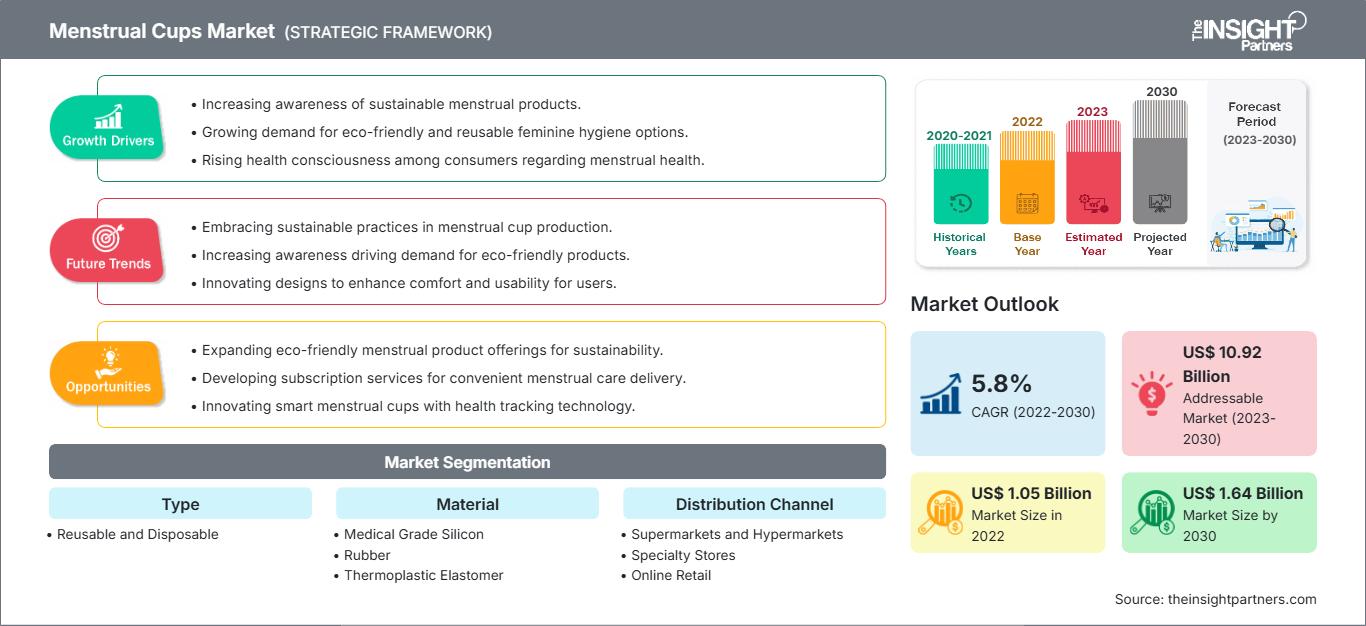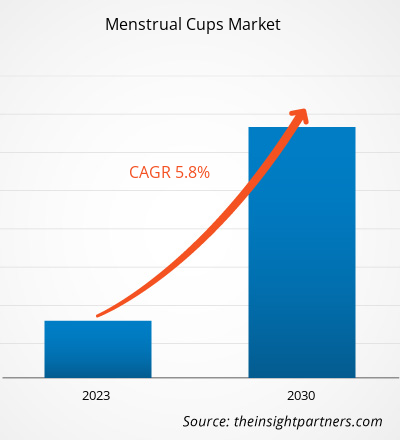[연구 보고서] 생리컵 시장 규모는 2022년 10억 5,081만 달러로 평가되었으며, 2030년에는 16억 4,406만 달러에 이를 것으로 예상됩니다. 2022년부터 2030년까지 연평균 성장률(CAGR)은 5.8%에 이를 것으로 예상됩니다.
시장 분석 및 분석가 의견:
생리컵은 생리 기간 동안 여성의 위생을 위해 설계된 재사용 가능한 종 모양의 기구입니다. 일반적으로 의료용 실리콘 또는 고무로 제작된 이 컵은 기존 탐폰이나 패드처럼 생리혈을 흡수하는 대신 질에 삽입하여 생리혈을 모읍니다. 생리혈 누출을 방지하는 밀봉 기능을 제공하며, 최대 12시간 동안 착용 후 비울 수 있어 일회용 제품에 비해 지속 가능하고 비용 효율적인 대안을 제공합니다. 월경컵은 기존 생리용품에 비해 환경적 이점과 장기적인 비용 절감 효과로 인기를 얻고 있습니다.
성장 동력 및 과제:
지속 가능한 생리용품에 대한 수요 급증은 생리컵 시장의 주요 성장 동력입니다. 최근 몇 년 동안 전 세계적으로 지속가능성을 향한 움직임이 활발해지면서 소비자들은 기존 일회용 생리용품의 환경적 영향에 대한 인식이 높아지고 있습니다. 기존의 패드와 탐폰은 플라스틱 폐기물 발생량이 상당히 높으며, 생산 과정에서 자원과 에너지 소비가 발생합니다. 매년 평균 여성 한 명이 약 150kg의 비분해성 폐기물을 버립니다. 인도에서만 약 1억 2,100만 명의 여성과 소녀들이 매달 평균 8개의 일회용 및 비퇴비성 패드를 사용하며, 이로 인해 매달 10억 2,100만 개의 패드, 매년 123억 개의 패드, 그리고 연간 11만 3,000톤의 생리 폐기물이 발생합니다. 사람들이 재사용 가능한 친환경적인 대안을 찾음에 따라 생리컵이 주요 선택지로 부상했습니다. 이처럼 높아진 환경 의식은 소비자들이 생태 발자국을 최소화하는 제품을 선택하도록 이끌며 생리컵 수요를 증가시키고 있습니다.
지속 가능한 생리용품에 대한 수요 증가는 여성의 건강과 웰빙을 옹호하는 광범위한 운동과 밀접한 관련이 있습니다. 소비자들은 환경에 좋을 뿐만 아니라 안전하고 건강에도 이로운 제품을 점점 더 우선시하고 있습니다. 일반적으로 의료용 실리콘, 고무 또는 열가소성 엘라스토머로 만들어진 생리컵은 안전하고 위생적인 것으로 간주되어 기존 제품에서 흔히 발생하는 자극 및 알레르기 반응 위험을 줄여줍니다. 환경적 지속가능성과 여성 건강에 대한 인식이 생리컵의 매력을 높이고 있으며, 이는 생리컵의 인기 상승을 촉진하는 요인입니다.
요구 사항에 맞게 이 보고서를 사용자 정의하십시오.
이 보고서의 일부, 국가 수준 분석, Excel 데이터 팩을 포함하여 모든 보고서에 대한 사용자 정의를 무료로 받을 수 있을 뿐만 아니라 스타트업 및 대학을 위한 훌륭한 제안 및 할인을 이용할 수 있습니다
월경컵 시장: 전략적 통찰력

-
이 보고서의 주요 주요 시장 동향을 확인하세요.이 무료 샘플에는 시장 동향부터 추정 및 예측에 이르기까지 데이터 분석이 포함됩니다.
일회용 제품의 환경적 영향에 대한 인식을 제고하기 위한 다양한 옹호 단체, NGO, 그리고 정부 정책에 의해 생리용품의 지속가능성에 대한 요구가 증폭되었습니다. 지속가능한 생리를 장려하는 캠페인은 생리컵과 같은 재사용 가능한 대안의 이점을 대중에게 알리는 데 중요한 역할을 했습니다. 지속가능한 생리 관행에 대한 인지도와 지지가 높아짐에 따라 소비자들의 태도가 긍정적으로 변화하여 생리컵에 대한 수용과 채택이 더욱 확대되었습니다.
지속가능한 생리용품에 대한 수요는 친환경적인 선택을 중시하는 젊은 세대 소비자들 덕분에 더욱 촉진되고 있습니다. 특히 밀레니얼 세대와 Z세대는 개인 위생용품을 포함한 다양한 산업 분야에서 지속가능하고 윤리적인 제품에 대한 수요를 주도하고 있습니다. 이러한 인구 통계학적 특성과 선호도는 시장 동향에 영향을 미치며, 지속가능하고 미래 지향적인 선택지인 생리컵은 그들의 가치관과 잘 부합합니다. 이 인구층의 구매력이 지속적으로 증가함에 따라 생리컵 수요 또한 증가하여 시장에서 지속 가능한 생리용품으로서의 입지를 더욱 공고히 할 것입니다.
그러나 소비자의 인식 부족과 낮은 인지도는 생리컵 시장에 상당한 제약으로 작용하여 전 세계 도입률에 영향을 미치고 있습니다. 많은 사람들이 포괄적인 교육 및 인식 캠페인 부족으로 생리컵의 이점에 대해 잘 알지 못하고 있습니다. 비용 효율성, 환경 영향 감소, 착용 시간 연장과 같은 생리컵의 장점과 제품에 대한 익숙하지 않은 인식은 잠재적 사용자들이 기존 생리용품에서 벗어나기를 꺼리게 만드는 요인입니다. 이러한 지식 부족은 오해와 거부감을 불러일으켜 생리컵이 실용적이고 실용적인 대안으로 널리 받아들여지는 것을 저해할 수 있습니다.
생리컵 사용을 주저하는 이유는 종종 삽입과 제거의 어려움에 대한 우려 때문입니다. 많은 소비자들이 생리컵 사용에 따르는 학습 곡선을 장벽으로 여기며, 자신에게는 없는 수준의 기술이나 편의성이 필요하다고 생각합니다. 생리컵의 간편한 사용법과 잠재적인 건강상의 이점에 대한 이해 부족이 이러한 우려를 증폭시킵니다. 이러한 선입견과 오해를 해소하기 위해서는 생리컵의 사용 편의성, 편안함, 그리고 긍정적인 환경적 영향을 강조하는 집중적인 교육 노력이 필요합니다. 이러한 우려를 해소하고 인식을 제고함으로써 시장은 오해를 해소하고 잠재적 사용자들에게 생리컵에 대한 긍정적인 인식을 심어줄 수 있습니다.
보고서 세분화 및 범위:
글로벌 생리컵 시장은 유형, 소재, 유통 채널, 그리고 지역을 기준으로 세분화됩니다. 유형별로는 재사용 가능 제품과 일회용 제품으로 구분되며, 소재별로는 의료용 실리콘, 고무, 열가소성 엘라스토머로 구분됩니다. 유통 채널별로 시장은 슈퍼마켓 및 하이퍼마켓, 전문점, 온라인 소매점 등으로 분류됩니다. 지역별로는 북미, 유럽, 아시아 태평양, 중동 및 아프리카, 중남미로 크게 세분화됩니다.
세분화 분석:
생리컵 시장은 유형에 따라 재사용 가능 제품과 일회용 제품으로 구분됩니다. 재사용 가능 제품은 2022년부터 2030년까지 가장 높은 연평균 성장률(CAGR)을 기록할 것으로 예상됩니다. 재사용 가능 생리컵은 생리 위생에 있어 지속 가능하고 비용 효율적인 혁명을 나타냅니다. 일반적으로 의료용 실리콘, 고무 또는 열가소성 엘라스토머로 제작된 이 종 모양의 생리컵은 기존 탐폰이나 패드처럼 생리혈을 흡수하는 대신 질에 삽입하여 생리혈을 모읍니다. 소재의 유연성과 부드러움은 사용자의 신체 구조에 맞춰 편안함과 사용 편의성을 보장합니다. 재사용 가능한 생리컵은 최대 12시간까지 착용할 수 있어 누출 방지 기능을 제공하고 사용자가 생리 기간을 더욱 유연하게 관리할 수 있도록 합니다. 가장 큰 장점 중 하나는 재사용이 가능하여 환경에 미치는 영향입니다. 이 컵은 생리 폐기물의 양을 크게 줄여 친환경적인 생리 관리 루틴을 구축하는 데 기여합니다. 또한, 장기적인 비용 절감 효과와 일회용품을 정기적으로 구매할 필요가 없다는 편의성 덕분에 재사용 가능한 생리컵은 지속 가능하고 실용적인 생리 위생 대안을 찾는 사용자들에게 점점 더 인기를 얻고 있습니다.
지역 분석:
생리컵 시장은 북미, 유럽, 아시아 태평양, 중남미, 중동 및 아프리카의 5개 주요 지역으로 구분됩니다. 북미는 2022년 세계 생리컵 시장을 주도했으며, 이 지역의 시장 규모는 3억 9,541만 달러에 달했습니다. 유럽은 세계 시장의 30% 이상을 차지하며 두 번째로 큰 시장 기여 국가입니다. 아시아 태평양 지역은 2022년부터 2030년까지 5% 이상의 상당한 연평균 성장률(CAGR)을 기록할 것으로 예상됩니다. 아시아 태평양 지역의 생리컵 수요 급증은 문화적 변화, 인식 제고, 여성 건강의 중요성 증대 등 다양한 요인에 기인합니다. 여러 아시아 국가에서 생리에 대한 금기를 깨려는 움직임이 증가하고 있습니다.
COVID-19 팬데믹의 영향:
COVID-19 팬데믹은 제조 시설 폐쇄, 노동력 부족, 공급망 차질, 재정 불안정 등으로 인해 초기에는 글로벌 생리컵 시장에 큰 타격을 입혔습니다. COVID-19 발생으로 인한 경기 침체로 인해 여러 산업의 운영이 중단되면서 생리컵 공급이 제한되었습니다. 또한, 여러 매장이 문을 닫으면서 생리컵 판매가 제한되었습니다. 그럼에도 불구하고, 2021년 여러 국가에서 이전에 부과되었던 제한 조치가 해제되면서 기업들은 입지를 넓히기 시작했습니다. 더욱이, 여러 국가 정부가 코로나19 백신 접종을 확대하면서 상황이 완화되어 전 세계적으로 사업 활동이 증가했습니다. 월경컵 시장을 포함한 여러 시장은 봉쇄 및 이동 제한 완화 이후 성장을 기록했습니다.
월경컵 시장 지역별 분석
The Insight Partners의 분석가들은 예측 기간 동안 생리컵 시장에 영향을 미치는 지역별 동향과 요인들을 면밀히 분석했습니다. 이 섹션에서는 북미, 유럽, 아시아 태평양, 중동 및 아프리카, 그리고 중남미 지역의 생리컵 시장 세분화 및 지역별 분포도 살펴봅니다.
월경컵 시장 보고서 범위
| 보고서 속성 | 세부 |
|---|---|
| 시장 규모 2022 | US$ 1.05 Billion |
| 시장규모별 2030 | US$ 1.64 Billion |
| 글로벌 CAGR (2022 - 2030) | 5.8% |
| 이전 데이터 | 2020-2021 |
| 예측 기간 | 2023-2030 |
| 다루는 세그먼트 |
By 유형
|
| 포함된 지역 및 국가 |
북미
|
| 시장 선도 기업 및 주요 회사 프로필 |
|
월경컵 시장 참여자 밀도: 비즈니스 역학에 미치는 영향 이해
생리컵 시장은 소비자 선호도 변화, 기술 발전, 그리고 제품 효능에 대한 인식 제고 등의 요인으로 인해 최종 사용자 수요가 증가함에 따라 빠르게 성장하고 있습니다. 수요가 증가함에 따라 기업들은 제품 라인업을 확장하고, 소비자 니즈를 충족하기 위한 혁신을 추진하며, 새로운 트렌드를 적극 활용하고 있으며, 이는 시장 성장을 더욱 가속화하고 있습니다.

- 을 얻으세요 월경컵 시장 주요 주요 플레이어 개요
경쟁 환경 및 주요 회사:
Nixit, Lunette Global, Lena Cup LLC, Diva International Inc., Saalt, Pixie Cup, June Cup, Cora, The Flex Company, Blossom Cup은 글로벌 월경컵 시장에서 활동하는 대표적인 기업입니다.
- 과거 분석(2년), 기준 연도, CAGR을 포함한 예측(7년)
- PEST 및 SWOT 분석
- 시장 규모 가치/거래량 - 글로벌, 지역, 국가
- 산업 및 경쟁 환경
- Excel 데이터세트
최근 보고서
사용 후기
구매 이유
- 정보에 기반한 의사 결정
- 시장 역학 이해
- 경쟁 분석
- 고객 인사이트
- 시장 예측
- 위험 완화
- 전략 기획
- 투자 타당성 분석
- 신흥 시장 파악
- 마케팅 전략 강화
- 운영 효율성 향상
- 규제 동향에 발맞춰 대응






















 무료 샘플 받기 - 월경컵 시장
무료 샘플 받기 - 월경컵 시장